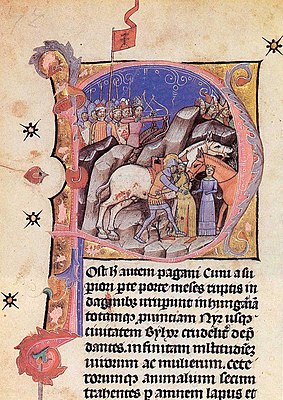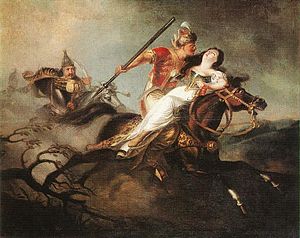|
Battle of Kerlés
The Battle of Kerlés (Hungarian: kerlési csata) also known as the Battle of Cserhalom (Hungarian: cserhalmi csata), was an engagement between an army of Pechenegs and Ouzes commanded by Osul[Note 1] and the troops of King Solomon of Hungary and his cousins, Dukes Géza and Ladislaus, in Transylvania in 1068. The Pechenegs had been the dominant power of the westernmost regions of the Eurasian steppes since around 895. However, large Pecheneg groups moved to the Balkan Peninsula at the same time as the westward migration of the Ouzes and Cumans in the 1040s. The first recorded Pecheneg invasion of Transylvania occurred during the reign of Stephen I of Hungary (r. 997–1038). In 1068, the invaders broke into Transylvania through the passes of the Carpathian Mountains. Archaeological finds suggest that they destroyed at least three fortresses made of earth and timber, including the ones at Doboka (now Dăbâca in Romania) and Sajósárvár (present-day Șirioara). They also made a plundering raid in the Nyírség region, to the west of Transylvania. After taking much booty, they planned to leave Hungary, but the Hungarians ambushed and annihilated them at a hill near Doboka. According to a popular legend, a "Cuman" warrior tried to escape from the battlefield, taking a Hungarian girl, but Duke Ladislaus defeated and killed him in single combat. BackgroundThe Pechenegs were the dominant power of the Pontic steppes between around 895 and 1055.[1][2] Around 895, they defeated the Magyars, or Hungarians, forcing them to leave the steppes and settle in Central Europe.[3][4] About 45 years later, the Byzantine Emperor Constantine VII Porphyrogenitus recorded that one of the Pecheneg "provinces" – the territory dominated by one of the eight Pecheneg tribes – bordered on the land controlled by the Hungarians.[5] According to the same source, the Pechenegs' land was "distant ... a four days journey"[6] from Hungary.[7] There are no records of enmity between the Pechenegs and the Hungarians in the 10th century.[7] On the contrary, they jointly invaded the Byzantine Empire in 934, according to the contemporaneous Arab geographer, Al-Masudi.[7][2]  The Pechenegs regularly invaded the Byzantine Empire from around 1026, suggesting a movement west from the lands east of the Dnieper to the region of the Lower Danube.[8] The Byzantine historians John Skylitzes and George Kedrenos mention clashes between the Pechenegs and their eastern neighbors, the Ouzes in the 1040s.[8][9] The Ouzes had been forced west across the Volga River by the Cumans.[10] Skylitzes and Kedrenos also wrote of armed conflicts between groups of Pechenegs.[9][11] After being defeated in such an intertribal conflict, two Pecheneg clans migrated to the Byzantine Empire in the early 1040s.[9] Pressured by both the Cumans and the Rus' princes, the Ouzes moved to the Lower Danube region in 1060.[12][13] The Cumans routed a Rus' force in 1061 and the united armies of the allied Rus' princes in 1068, which enabled them to take control of the western regions of the Eurasian steppes.[14] Hungary was exposed to raids by the neighboring nomadic peoples.[15] Coins minted for King Stephen and his successor, Peter, have been found at Torda and Kolozsvár (now Turda and Cluj-Napoca in Romania), and other places, showing that the nearby fortresses were in use in the first half of the 11th century.[16] The Pechenegs made a plundering raid into Transylvania during the reign of King Stephen, according to the king's legends.[17][8] The chronicle of Henry of Mügeln records the raid as occurring in 1028.[8] Abbot Thierry of St Hubert-en-Ardenne, who wanted to travel through Hungary during his pilgrimage to the Holy Land in 1053, was forced to return because of an "incursion of barbarians" into Hungary.[18][19] Historian Jonathan Riley-Smith associates these barbarians with the Pechenegs.[18] The invasion of the Kingdom of Hungary which ended with the Battle of Kerlés occurred during the reign of King Solomon of Hungary.[20] Solomon had ascended the throne with German assistance at the age of ten in 1063.[21] His cousins, Géza, Ladislaus and Lampert, tried to dethrone him with Polish assistance, but he made peace with them, granting Géza their father's duchy which included the parts of Hungary to the east of the River Tisza.[22] Duke Géza's main residence was in the fortress of Bihar (now Biharia in Romania).[23] Battle The Illuminated Chronicle and other 14th- and 15th-century Hungarian chronicles preserve detailed reports of the 1068 invasion of the eastern regions of Hungary.[24][25] The Illuminated Chronicle states that the commander of the invaders, Osul, was the retainer of "Gyula, Duke of the Comans".[26][24] On the other hand, Simon of Kéza – who thought that the battle had occurred during the reign of Solomon's cousin, Ladislaus – recorded that the marauders were Bessi, or Pechenegs, arch-enemies of the Hungarians[27] in his Gesta Hunnorum et Hungarorum.[25] The Annales Posonienses also states that the marauders were Pechenegs, but misdates the battle to 1071.[25][28] The invasion was misdated to 1059 in a west-Russian chronicle which identified the invaders as Cumans and Vlachs (Romanians).[25] Modern historians agree that the invaders of 1068 were Pechenegs or Pechenegs and Ouzes; in medieval Hungarian chronicles the ethnonym Cuni included all nomadic Turkic peoples.[25][20] Historian István Bóna writes that the reference to "Gyula, Duke of the Comans" in the Illuminated Chronicle preserved the memory of the Pechenegs' Jula tribe who dwelt to the west of the River Dniester.[24] A layer of black soil and other signs of a general destruction by fire, which have been dated to King Solomon's reign, suggest that the fortresses, built of earth and timber, at Doboka, Kolozsvár and Sajósárvár were destroyed in the 1060s.[29][30] Alexandru Madgearu, István Bóna and other scholars attribute the destruction of the Transylvanian fortresses to the invasion of 1068.[29][30] The invaders broke into Transylvania through the passes of the Carpathian Mountains.[25] According to historian Florin Curta, the invasion shows that the province prospered in the 1060s.[17] The Pechenegs crossed the "Gate of Meses"[26] and plundered the Nyírség region, reaching as far as the fortress at Bihar.[25] After plundering much booty, they returned to Transylvania along the valley of the River Someș, planning to return to their homeland through the Borgó Pass (the Tihuța Pass, now in Romania).[20][31] King Solomon and his cousins, Dukes Géza and Ladislaus, gathered their troops at the fortress of Doboka to give battle to the marauders near the confluence of the Rivers Beszterce and Sajó (now the Bistrița and the Șieu, respectively).[20][31] A scout from Marosújvár (now Ocna Mureș in Romania) informed the Hungarian army of the movements of the enemy.[31] In an attempt to avoid the battle, the Pechenegs fled to a hill where the Hungarians annihilated them.[31] The hill was named for the Hungarians' battle cry – Kyrie eleis, according to Bóna.[31] The alternative name of the battle (Battle of Cserhalom) derives from the misspelling of the name by Antonio Bonfini, who wrote of "Cherhelem" instead of "Kyrie eleis".[31] LegendThe most famous legend of Duke Ladislaus – who was canonized as King St Ladislaus – took place during the Battle of Kerlés.[32] According to the legend, which incorporates elements of earlier Oriental tales, a "Cuman" warrior tried to escape from the battlefield, taking a beautiful girl from Nagyvárad with him. Duke Ladislaus fought a duel with the "Cuman", and despite being wounded he killed the "pagan".[33][34] The legend was recorded shortly after Ladislaus's death, because it identified the girl as the daughter of the Bishop of Várad, and Ladislaus's successor, Coloman the Learned, prohibited the marriage of bishops.[31] The legend was depicted on the walls of many churches in the Kingdom of Hungary, especially in the northern and southeastern territories (in present-day Slovakia and Romania).[31][34] References
NotesSourcesPrimary sources
Secondary sources
|
||||||||||||||||||||||||
